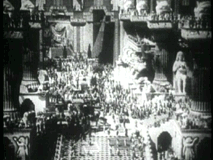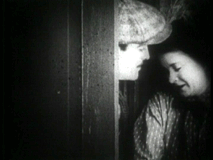|
Newest Reviews:
New Movies -
The Tunnel
V/H/S
The Tall Man
Mama Africa
Detention
Brake
Ted
Tomboy
Brownian Movement
Last Ride
[Rec]³: Genesis
Hara-Kiri: Death of a Samurai
Indie Game: The Movie
Abraham Lincoln: Vampire Hunter
Old Movies -
Touki Bouki: The Journey of the Hyena
Drums Along the Mohawk
The Chase
The Heiress
Show
People
The Strange Affair of Uncle Harry
Pitfall
Driftwood
Miracle Mile
The Great Flamarion
Dark Habits
Archives -
Recap: 2000,
2001, 2002,
2003, 2004
, 2005, 2006,
2007 , 2008
, 2009 ,
2010 , 2011 ,
2012
All reviews alphabetically
All reviews by star rating
All reviews by release year
Masterpieces
Screening Log
Links
FAQ
E-mail me
HOME
| |
Intolerance (D.W. Griffith) 1916
 Easily one of the most audacious films ever made, Intolerance,
D.W. Griffith’s collection of epics, continues to inspire films that marvel at
its expansive excess (Todd Haynes’ Poison
and Darren Aronofsky’s Requiem for a
Dream spring immediately to mind). Spanning four time periods, the film
tells four disparate stories in parallel under the pretense that they all
similarly show grave examples of the evils of man’s intolerance. The stories
are all engaging, even if not equally so, and the film never flags during its
ample running time. Still, this feels at times like a great experiment in which
Griffith can test the capabilities of his montage aesthetics. He cuts across the
four stories, linking them with the unifying image of a mother rocking a
child’s cradle, and the simultaneous climax of the tales is decidedly
impressive. The cross-cutting would be more impressive, however, if Griffith was
able to find a more consistent rhythm. The ending montage achieves a unified
tempo that should be more consistent throughout. As it stands, some of the stories
are shown for a half-hour at a time. The Babylonian and modern tales are more
thoroughly told during the length of the film than the passion play and the
French tales are, and as such their inclusion in the ending seems almost
distracting. One can’t help but feel that those two stories would stand better
on their own (indeed, the Babylonian story was released as separate features
after Intolerance failed at the box office).
Easily one of the most audacious films ever made, Intolerance,
D.W. Griffith’s collection of epics, continues to inspire films that marvel at
its expansive excess (Todd Haynes’ Poison
and Darren Aronofsky’s Requiem for a
Dream spring immediately to mind). Spanning four time periods, the film
tells four disparate stories in parallel under the pretense that they all
similarly show grave examples of the evils of man’s intolerance. The stories
are all engaging, even if not equally so, and the film never flags during its
ample running time. Still, this feels at times like a great experiment in which
Griffith can test the capabilities of his montage aesthetics. He cuts across the
four stories, linking them with the unifying image of a mother rocking a
child’s cradle, and the simultaneous climax of the tales is decidedly
impressive. The cross-cutting would be more impressive, however, if Griffith was
able to find a more consistent rhythm. The ending montage achieves a unified
tempo that should be more consistent throughout. As it stands, some of the stories
are shown for a half-hour at a time. The Babylonian and modern tales are more
thoroughly told during the length of the film than the passion play and the
French tales are, and as such their inclusion in the ending seems almost
distracting. One can’t help but feel that those two stories would stand better
on their own (indeed, the Babylonian story was released as separate features
after Intolerance failed at the box office).
 The film is as filled with heavy-handed Victorian morality as anything that
Griffith made, but the director frequently finds moments to pornographically
stare at a decapitation or a cheesecake shot in the midst of his moralizing. The
extended Babylonian battle sequence is perhaps the most spectacular in the film,
and Constance Talmadge’s performance as the rugged mountain girl in this
segment is the film’s most memorable, but none of the acting in the film is
bad. The costume design and the sets are incredibly detailed, and you find
yourself wishing a director like von Sternberg was behind the camera so we could
get a more detailed look at them. Griffith seems more interested in pointing out
the veracity of their reconstruction during his intertitles. If Griffith’s
ambition occasionally gets the better of him in this film, it also is the
obvious result of his conviction that he was telling a story that needed to be
told in a medium that hadn’t yet been pushed this far (and rarely has been
since). So many early silent films are exciting because they were made while the
rules about what the movies should be were still being written, and Intolerance
seems to be utterly boundless in its best moments. That it sometimes feels
embarrassing in its simplicity is forgivable considering its achievements.
The film is as filled with heavy-handed Victorian morality as anything that
Griffith made, but the director frequently finds moments to pornographically
stare at a decapitation or a cheesecake shot in the midst of his moralizing. The
extended Babylonian battle sequence is perhaps the most spectacular in the film,
and Constance Talmadge’s performance as the rugged mountain girl in this
segment is the film’s most memorable, but none of the acting in the film is
bad. The costume design and the sets are incredibly detailed, and you find
yourself wishing a director like von Sternberg was behind the camera so we could
get a more detailed look at them. Griffith seems more interested in pointing out
the veracity of their reconstruction during his intertitles. If Griffith’s
ambition occasionally gets the better of him in this film, it also is the
obvious result of his conviction that he was telling a story that needed to be
told in a medium that hadn’t yet been pushed this far (and rarely has been
since). So many early silent films are exciting because they were made while the
rules about what the movies should be were still being written, and Intolerance
seems to be utterly boundless in its best moments. That it sometimes feels
embarrassing in its simplicity is forgivable considering its achievements.
* * * 1/2
5-10-02
Jeremy Heilman
|